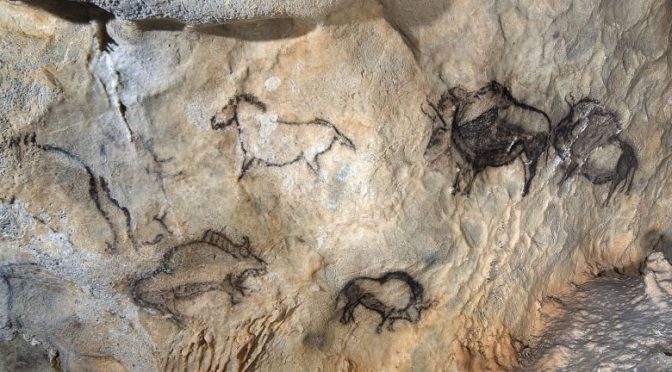We often associate prehistory with caves, with literal cavemen and cavewomen who sought shelter from the elements and predators within the safety of chasms and grottos. The Basque Country, a place where mountains meet the sea, is full of caves, caverns, and subterranean tunnels. These natural shelters have played a huge role in the history, mythology, and religion of the Basque Country.

- Of course, the Basque Country is famous for its prehistoric caves, the cave art that has been discovered within them, and what all of this tells us about the prehistoric history of the area. Perhaps the most famous is Santimamiñe, located in the Urdabai reserve in Bizkaia. It was discovered in 1916 by a group of kids. With cave paintings depicting bison, horses, deer, goats, and brown bears, the evidence points to human inhabitance about 13,000 years ago.
- However, there are caves with even older evidence of human existence in the Basque Country. In a study led by Blanca Ochoa published in the journal Antiquity, the researchers describe the discovery of 17 new caves containing art between 20,000 and 40,000 years old. These new caves are important because the art they contain represents two different styles, suggesting the region was at the border between two different cultures. And, in a paper led by Diego Garate in the journal PLoS ONE, other researchers found carvings dating 25,000 years old in caves in Aitzbitarte that are stylistically similar to those found in other parts of Europe, suggesting that the prehistoric inhabitants of the Basque Country were not as isolated as previously thought.
- Caves also feature heavily in the stories and myths of the Basque Country. There are lots of stories connecting various caves and chasms to specific houses and even kitchens throughout the Basque Country. These houses, once believed to connect to a vast underground system of tunnels, provided special connections with mythical beings and the spirits of ancestors.
- Mari, the mythical Basque Mother Earth figure, is said to dwell in caves. Her dwellings are scattered throughout the region, in every province of the Basque Country. The Basajaun, the lord of the forest, also often makes his home in a cave, as do the Lamia.
- Finally, caves have also played a more recent role in religious life. Hermitages dedicated to numerous saints, including Saint Thyrsus, Saint Barthélemy, Saint Raymond Nonnatus, Saint Marina, and Saint Adrian, are found in caves across the landscape. For example, in Aralar, there is a sanctuary dedicated to Saint Michael which used to be the home of the Herensuge, the mythical Basque dragon. There is a hole, said to connect to underground caverns where victims were offered to the Herensuge. There is a custom for pilgrims to stick their heads into that hole while praying, which protects them from headaches during the coming year.
Primary sources: Barandiaran Ayerbe, José Miguel de. Harpe. Auñamendi Encyclopedia, 2020. Available at: http://aunamendi.eusko-ikaskuntza.eus/en/harpe/ar-4480/; Cowie, Ashley. 40,000-Year-Old Cave Art Fills Basque Country Void, 2020. Ancient Origins.
Discover more from Buber's Basque Page
Subscribe to get the latest posts sent to your email.



2 thoughts on “Basque Fact of the Week: Caves and Caverns of the Basque Country”